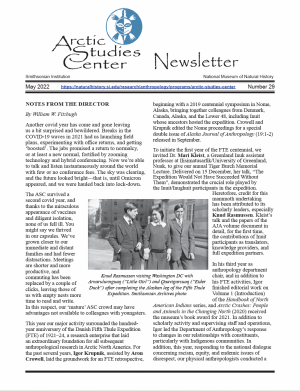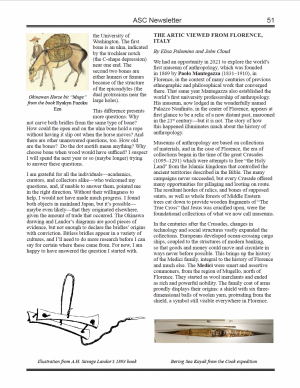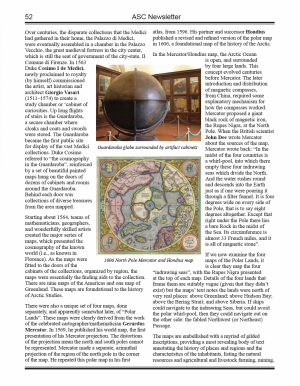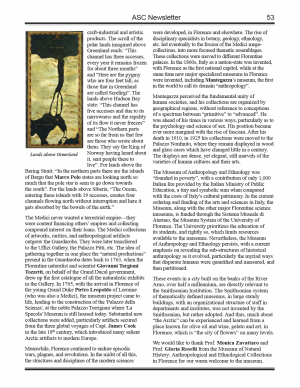Palomino, E., Cloud, J. (2022) The Arctic as viewed from Florence. Arctic Studies Center Newsletter, Smithsonian National Museum of Natural History.
We had an opportunity in 2021 to explore the world’s first museum of anthropology, which was founded in 1869 by Paolo Mantegazza (1831–1910), in Florence, in the context of many centuries of previous ethnographic and philosophical work that converged there. That same year Mantegazza also established the world’s first university professorship of anthropology. His museum, now lodged in the wonderfully named Palazzo Nonfinito, in the center of Florence, appears at first glance to be a relic of a now distant past, marooned in the 21st century—but it is not. The story of how this happened illuminates much about the history of anthropology.
Museums of anthropology are based on collections of materials, and in the case of Florence, the era of collections began in the time of the great Crusades (1095–1291) which were attempts to free “the Holy Land” from the Islamic kingdoms that controlled the ancient territories described in the Bible. The many campaigns never succeeded, but every Crusade offered many opportunities for pillaging and looting on route. The resultant hordes of relics, and bones of supposed saints, as well as whole forests of Middle Eastern trees cut down to provide wooden fragments of “The True Cross” that Jesus was crucified upon, were the foundational collections of what we now call museums.
In the centuries after the Crusades, changes in technology and social structures vastly expanded the
collections. Europeans developed ocean-crossing cargo ships, coupled to the structures of modern banking, so that goods and money could move and circulate in ways never before possible. This brings up the history of the Medici family, integral to the history of Florence and much else. The Medici were smart and assertive commoners, from the region of Mugello, north of Florence. They started as wool merchants and ended as rich and powerful nobility. The family coat of arms proudly displays their origins: a shield with six threedimensional balls of woolen yarn, protruding from the
shield, a symbol still visible everywhere in Florence.
https://repository.si.edu/handle/10088/116098
- Palomino, E., Pardue, J., Donkan, A. (2023) Fish skin Peoples of the Bering Strait: Encounters in Hokkaido, Japan. Smithsonian Institution National Museum of natural History. Arctic Studies Center Newsletter. May 2023. N.30. pp.74-75
- Palomino, E. (2022) Indigenous Arctic Fish Skin Heritage: Sustainability, Craft and Material Innovation. PhD Thesis. University of the Arts, London.
- Palomino, E., Cloud, J. (2022) The Arctic as viewed from Florence. Arctic Studies Center Newsletter, Smithsonian National Museum of Natural History.
- Palomino, E. (2021) Fish Skin Coat from the Amur River. TEXT for the Study of the History Art Design of Textiles. V. 48: 2021. The Textiles Society, Pat Frost (ed)
- Trachter, F., Palomino, E., Defeo, G. (2021) Patagonian fish skin tanning processes. XXXVI IULTCS Congress Greening the Leather Value Chain
- Palomino, E., Pardue, J. (2021) Alutiiq Fish Skin Traditions: Connecting Communities in the COVID-19 Era. MDPI Heritage, 4, x. Academic Editor(s): Claire Smith.
- Palomino, E., Pardue, J., (2021) A virtual Alutiiq Fish Skin workshop during Covid-19 times. Smithsonian Institution National Museum of natural History. Arctic Studies Center Newsletter. May 2021. N.30.pp-16-17
- Palomino, E., Freilich, O., Raine, I. (2021) 'A virtual Ainu fish skin workshop during Covid 19'. Global Fashion conference. Academy of Fine Arts of Warsaw. ISBN: 978-989-54263-2-4
- Palomino, E., Karadottir, K. (2021) Fish skin, a historical material assimilated as a sustainable material for fashion. In: Fashion: Culture, Craft, and Identity. Brill.
- Palomino, E., Boon, J. (2020) Preservation of Hezhen Fish Leather tradition through Fashion Education. Textiles, Identity and Innovation. Taylor & Francis.
- Palomino, E. (2020) Fashion workshop in Anchorage. Smithsonian Institution National Museum of natural History. Arctic Studies Center Newsletter. May 2020. N.27.pp. 57-58
- Palomino, E., Karadottir, K., Phirry, E. (2020) Indigenous Fish Skin Craft Revived Through Contemporary Fashion. International Foundation of Fashion Technology Institutes Journal. ISSN: 2694-5193
- Palomino, E. Defeo, G. (2019) Material Design Research - Fish skin, a new environmental -friendly material for fashion. Design Research for Change. Design Museum, London ISBN 978-1-86220-369-3
- Palomino, E. Rahme, L. Karadottir, K. (2019) Indigenous Arctic Fish skin clothing traditions: Cultural and ecological impacts on Fashion HE. CUMULUS Conference Rovaniemi. ISBN 978-952-337-158-3.
- Palomino, E. (2019) SDG 14 Life Below Water Introducing Fish Skin as a Sustainable Raw Material for Fashion. In: Franco I., Chatterji T., Derbyshire E., Tracey J. (eds) Actioning the Global Goals for Local Impact. Science for Sustainable Societies. S



